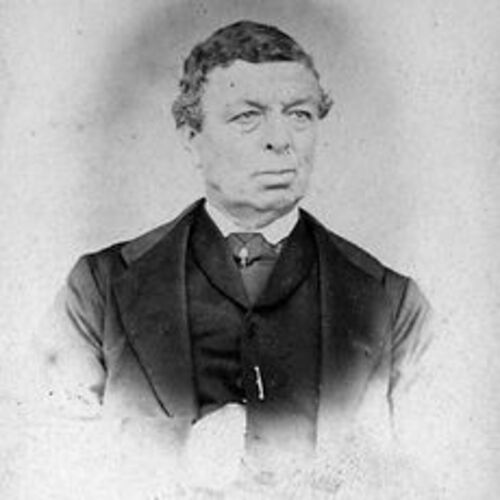As part of the funding agreement between the Dictionary of Canadian Biography and the Canadian Museum of History, we invite readers to take part in a short survey.
McNEILL, WILLIAM HENRY, master mariner, HBC chief factor, and pioneer; b. in Boston, Mass., 7 July 1801, son of William Henry and Rebecca McNeill; d. at Victoria, B.C., 3 Sept. 1875.
William Henry McNeill, like many of his New England contemporaries, answered the call of the sea when young. In 1823 he became a master mariner, and at the end of the following year commanded the brig Convoy on a trip to the Sandwich Islands (Hawaii) and to the Queen Charlotte Islands. For some years he traded between Massachusetts and South America, West Africa, and the Sandwich Islands, but in 1830 he was on the northwest coast of America working for the Boston merchants Bryant and Sturgis. His energy soon established him as one of the more successful fur-traders, and he refused to be coerced by the powerful Hudson’s Bay Company into abandoning the lucrative northwest coast. On one occasion, in April 1832, Captain Thomas Sinclair aboard the HBC brigantine Cadboro attempted to force McNeill to take his ship, the brig Lama, out of the competition; McNeill faced the challenge and Sinclair was obliged to back down.
Although Chief Factor John McLoughlin* of the Columbia District wanted to be rid of the competing American traders, he respected McNeill’s experience and ability and, in August 1832, needing another ship for the coastal trade to replace the damaged schooner Vancouver, McLoughlin arranged through his assistant Duncan Finlayson* for the purchase of Lama. McNeill and his two mates entered the service of the company at the same time, although McLoughlin knew that the HBC committee would object to his employing Americans; not until 1834 did he receive approval of McNeill’s appointment.
At first McNeill continued to command Lama, and in 1834 rescued three Japanese sailors whose junk had foundered off Cape Flattery and who were being held captive by Indians. Three years later, he received command of Beaver, first steamship on the Pacific coast. Although a mutiny of its crew early in 1838 marred his record, he was promoted chief trader in November 1839. The appointment meant that he would have to become a British subject and he travelled to London in 1842 for this purpose, but it does not appear that he changed his citizenship before 1853 when he took up land near Fort Victoria.
Back in the Columbia District in 1844, McNeill requested a transfer to a land establishment and in 1845 took charge of Fort Stikine. Three years later he moved to Fort George because of ill health, but in 1849 established Fort Rupert, on the north end of Vancouver Island, where he stayed one year. After a trip to the Sandwich Islands he took charge of Fort Simpson in 1851 and remained there till 1859. One of his more interesting experiences was a trip he made in 1851 in Una to investigate the gold deposits on the Queen Charlotte Islands. The local Indians were not cooperative; when the sailors set off blasts to loosen the gold-bearing rock, both Indians and sailors would rush into recover the more valuable pieces. Since the Indians were bellicose, dragging the seamen from the holes by their feet and threatening them with knives, McNeill was obliged to withdraw. His main concern, however, was trading for furs, and his journals and letters written at Fort Simpson indicate that he found the men at the post difficult to manage and the Tsimshians and other Indians a constant threat. The sale of spirits by American traders aggravated his problems; he wanted a gun boat to bring them under control. In 1856 his labours were rewarded when he was appointed a chief factor, and after a furlough from 1859 to 1861 he returned to Fort Simpson where he remained until he retired to his farm at Victoria in 1863.
Even in retirement McNeill was active. He was appointed to the British Columbia pilot board in 1868, and from 1872 until 1874 he captained the steamer Enterprise which operated between Vancouver Island and the mainland. He was a signatory to the 1869 petition addressed to President Ulysses S. Grant requesting the annexation of British Columbia to the United States. McNeill was married twice – to Mathilda who died in 1850 leaving one son and five daughters, and to Martha who was probably of the Nass tribe.
McNeill’s career with the HBC was long and distinguished. In the 1830s and 1840s he helped the company to overcome the tricky navigational problems of the coast. As master of a trading post he managed to establish with the Indians the relationship necessary for profitable trading.
PABC, W. H. McNeill journals and correspondence. Daily British Colonist (Victoria), 5 Sept. 1875. Daily British Colonist and Victoria Chronicle, 15 May 1868. HBRS, IV (Rich); VI (Rich); VII (Rich); XXII (Rich).
Cite This Article
G. R. Newell, “McNEILL, WILLIAM HENRY,” in Dictionary of Canadian Biography, vol. 10, University of Toronto/Université Laval, 2003–, accessed March 29, 2025, https://www.biographi.ca/en/bio/mcneill_william_henry_10E.html.
The citation above shows the format for footnotes and endnotes according to the Chicago manual of style (16th edition). Information to be used in other citation formats:
| Permalink: | https://www.biographi.ca/en/bio/mcneill_william_henry_10E.html |
| Author of Article: | G. R. Newell |
| Title of Article: | McNEILL, WILLIAM HENRY |
| Publication Name: | Dictionary of Canadian Biography, vol. 10 |
| Publisher: | University of Toronto/Université Laval |
| Year of revision: | 1972 |
| Access Date: | March 29, 2025 |



